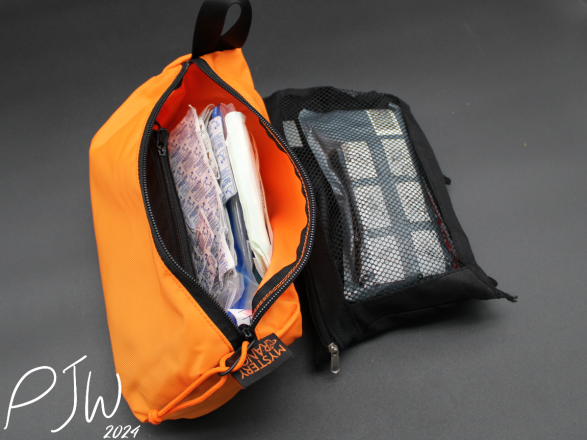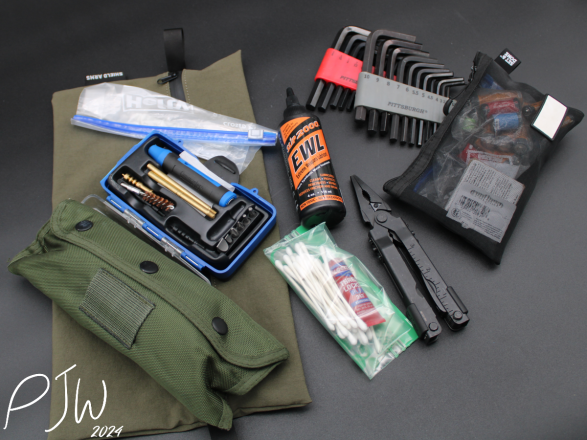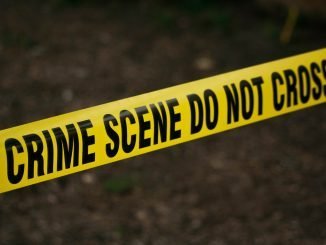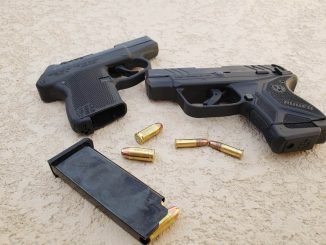
To improve as a shooter, we need to go out and shoot. Shocking revelation, I know. We can get a lot of repetitions and work done via dry fire, but we’ve still gotta head to the range and see our progress. Part of heading to the range is packing support gear that can facilitate your growth as a shooter. As Benjamin Franklin put it “By failing to prepare, you are preparing to fail”, so packing properly is certainly important. Below are 5 things that I think should be in every range bag (aside from your firearm/ammo and a holster). Some of these are individual items, while others are a small “kit” of pieces. This isn’t meant to be all encompassing, but rather the top 5 things that I pack into my range kit.
#1: An Individual First Aid Kit (IFAK)

Firearms are a deadly tool. They deserve the respect that deadly tools deserve, and as such, we need to practice proper handling of them. However, accidents and negligent behavior can happen, and being prepared to respond to a physical injury needs to happen. As such, there should be an IFAK in your range bag. Part of packing an IFAK means knowing how to use it too. Taking a Stop The Bleed and Red Cross First Aid Class are great places to start, but more medical training can’t hurt.
So what goes in an IFAK? Well, I keep tourniquets, gauze, pressure bandages, Quik Clot, nitrile gloves, chest seals, and a set of trauma shears in mine. I also pack a secondary boo-boo FAK, but that’s for minor ouchies. For your IFAK, you can buy a pre-made one, or pack it yourself. Again, training on how to use it is extremely important, and for most folks, buying a pre-made, complete one is likely the best choice.
#2: Ear & Eye Protection

You’ve only got one pair of eyes, and one pair of ears. We’ve got to preserve them the best that we can, which means packing protective gear for them. I’ve personally seen people receive eye damage from not wearing shooting glasses, and have certainly seen plenty of people receive hearing damage from not wearing ear protection. These are certainly mandatory in any shooter’s bag.
What should you get for eye protection? Well, ballistically rated lenses are a must, and thankfully they aren’t very expensive. I’d recommend a pair that is clear for shooting in overcast/night conditions, and a shaded pair for use on a sunny day.
For ear pro, I’d recommend two types of protection. Firstly, I’d recommend some form of ear plugs. Whether they be the simple orange 3M ones, or something like Surefire Sonic Defenders, something that you can cram into your ears is very useful. However, these aren’t the end-all-be-all. I’d also recommend a pair of quality electronic hearing protection. Good pairs (such as the Walker Razors) start around $45, and provide a ton of utility. They preserve your hearing well, but also allow you to still hear talking and non-gunshot sounds well. Most instructors require shooters to show up with electronic ear pro, and in 2024, I think that it should the norm.
The rationale for the inner ear protection is that it allows you to layer up under your outer ear protection, when shooting in very loud spots (indoor ranges mostly). Again, hearing loss and tinnitus are something that you don’t want. Protecting those eyes and ears are a must for the prepared shooter.
#3: Tools & Spare Parts

Packing tools and spare parts in your range bag is something that most folks should do. It can be a simple tool/repair kit, or it can be more fleshed out. What should be in that kit?
For tools, it really depends on the guns that you shoot. For me, a Torx/Allen/Phillips/Flathead screwdriver kit is always in my bag. With optics, lights, and screws in guns, the driver kit gets used quite often. I also keep a set of small punches, and a small cleaning kit. The punches help to disassemble guns if I need to pull guts out of the frame, and the cleaning kit is mostly there for using the cleaning rod for punching out squibbed bullets. Rounding out the last bit, I keep lube, a multitool (with pliers), and Loctite with q-tips in the kit. My little tool kit has been able to handle a lot of in-field jobs, generally on other folks’ guns. Sometimes you get to save the day for someone else when you pack a good toolkit.
When it comes to spare parts, I generally refer to batteries. Batteries always die when you don’t want them to, so packing spares for your optics, lights & ear pro are a must. For actual spare gun parts, I’m generally referring to wear components that we might wear out while in the field. This may mean packing a spare bolt if you shot an AR a ton, or keeping an extra recoil spring for your 1911 in your range bag. I’d also categorize specific firearm tools here too, like sight tools. I tend to do fairly good preventative maintenance on my firearms, so spare parts don’t play a massive role for me. However, when I’m testing a new gun/new parts in a gun, I tend to pack the OEM or other spare parts to swap components if I have an issue.
#4: Targets & Writing Utensils
Well, you’ve gotta shoot at something. As such, targets are a staple in my range bag. I pack a myriad of targets, to help diversify what I’m shooting at. B8s, 7″ paper plates, index cards, post-it notes, and specialized targets are generally riding with me. Part of packing targets is also packing a staple gun. I use a (previously reviewed) DeWalt stapler, and it has yet to let me down.
I’d also recommend packing some writing utensils to use on your targets. A permanent marker is great for marking your scores and times on drills, and is just generally handy to have. A pen is also helpful too, so that you can log things in a notebook, or write on targets.
These are simple items, but you’d be shocked on the number of times that I’ve shown up to shoots, and people don’t bring targets or writing utensils. Don’t be that person.
#5: A Shot Timer

To grow as a shooter, we have to find our skill limits. Part of doing that is tracking information, so that we have statistics to show performance, and progress. A shot timer is a very useful tool in that process, as it will allow us to have a random start for drills, and to track time while shooting them. This isn’t exactly new information, but it’s good to reiterate it.
There’s a handful of shot timers out there, and everyone has a personal preference for what they like. I’ve personally used the Pocket Pro 2 for the last 6 years, and I’ve got no gripes with it. Now, shot timers are really expensive, despite being fairly dated pieces of equipment. If you can’t afford one now, the Splits app on Google Play and the Shot Timer iOS app are a fine place to start. Having a random start, and a second beep to track max par can help a lot for many drills. Most phones don’t pick up gunshots well, so don’t expect it to be great. A cellphone app isn’t a stand-in for a shot timer in the long term, but it is a good place to start.
The Verdict
Those are 5 items that are always in my range bag. Now, there’s plenty more that would be good to pack (water, sunscreen, etc), but that’s my top 5 items. What’s in your range bag?
Patreon Link
If you’d like to support me on Patreon, I’ve got the link for that here. Nearly everything that I do on Primer Peak is paid for out of my own pocket, and my content is not shilled or driven by manufacturers or companies. If you decide to donate, I’d really appreciate it, as it would allow for me to continue to bring you quality work.






Be the first to comment